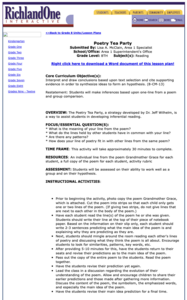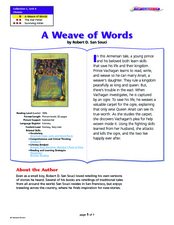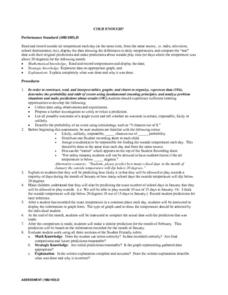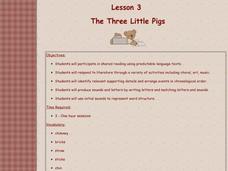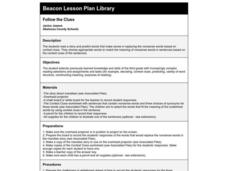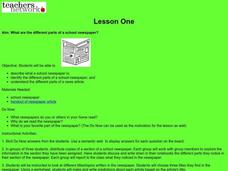Curated OER
A Plump and Perky Turkey
Help readers recognize elements in a story. They will use pictures and text to gain meaning from written material. Have learners listen to the story A Plump and Perky Turkey and participate in a discussion. They recognize the Internet...
Curated OER
Hoot: KWHL
How can we help endangered animals? Learn about which animals are endangered and what people can do to protect them with a lesson based on Carl Hiaasen's Hoot. After completing a KWHL chart to note what they already know and what they...
Curated OER
Poetry Tea Party
Studetns make inferences based upone one-line poetry and group comparison. In this poetry lesson, 9th graders read strips from a poem and write prediction sentences for the poem. Students read each other's poetry lines and then read the...
Curated OER
The Big E
Sixth graders explore predictions and estimation. In this math lesson, 6th graders analyze data and make predictions based on the past years data.
Curated OER
Sink or Float?
Students predict and explore to discover which objects sink or float in fresh and salt water, predict how salt affect objects, write predictions on T chart, discuss difference between man-made and natural waters, and graph results.
Curated OER
People of the Past
Young scholars investigate the four groups of people that existed in the U.S. before the European settlers arrived. They predict how the people arrived in the U.S., then investigate their predictions to find out whether or not they are...
Curated OER
Alphabet Study
Fifth graders predict what they believe the five most common letters are in the English language. After sharing their predictions in a group, they develop a new list of the most common letters used. Using a book, they count the number...
Curated OER
A Weave of Woods
Focus on vocabulary, comprehension, and analysis while reading A Weave of Woods, a colorful picture book by Robert D. San Souci. Young learners use worksheets to preview, predict, practice paraphrasing, and make comparisons. The richly...
Curated OER
Solar Electricity ~ The Colour Sensitivity of a Photovoltaic Cell
Teacher's notes, a materials list, detailed procedure, tips, and extension ideas are all included to make teaching this lesson on photovoltaic cells a sunny spot in your day! After some brief background reading, physical science...
Brigham Young University
Socratic Seminar for Cold Sassy Tree
Tired of giving the same old multiple-choice tests, and have the urge for a new assessment? Then bring the precision of a Socratic seminar into your classroom. Even if you did not read Cold Sassy Tree the organization and explanation on...
Federal Reserve Bank
Ten Mile Day
Get your class working on the railroad with this detailed and interactive lesson. After reading and discussing Ten Mile Day, learners explore division of labor, human capital, and productivity with a hands-on group activity in which they...
Curated OER
Eagle Song
Students read a book. In this comprehension instructional activity, students read the book Eagle Song stopping to answer comprehension questions about each chapter. Students complete post reading activities including a Tree of Peace.
Curated OER
New England Colonies
Students study the New England colonies. For this colonies lesson, students use a directed reading-thinking method to learn about the New England colonies. Students follow the method to make predictions, read the text, and analyze the...
Curated OER
Cold Enough?
Students read and record temperatures and display the data. They represent the temperatures on an appropriate graph and explain completely what was done and why it was done. Students display the data showing differences in the daily...
Curated OER
The Three Little Pigs
Students analyze storytelling by reading a classic children's tale. In this reading comprehension instructional activity, students read The Three Little Pigs, discuss their predictions and practice using the vocabulary from the story....
Curated OER
M & M Madness
M&M's are always a great manipulative to use when teaching math. In this graphing lesson plan, learners predict how many of each color of M & M's there are. They count up each color and plug the data into a graph using the...
Curated OER
Follow the Clues
Students read a story and predict words that make sense in replacing the nonsense words based on context clues. Students choose appropriate words that will match the meanings of the nonsense words.
Curated OER
From Seeds to Plants
Second graders review the process of plant reproduction and the role of seeds in that process. The students dissect a seed, analyze their finds, collect and record data, and make predictions about seed germination and plant growth.
Curated OER
Treasure Hunt
Students find lost "treasure" using a treasure map after being shown a map that you have created where terms and symbols are discussed. The class is divided into small groups where they locate your treasure and then read a section from...
Curated OER
Looking Back, Up and Ahead
Students explore how scientists have forecasted the 2002 Leonid meteor shower. They pose their own predictions for peak meteor rates per hour during the 2002 shower and compare their results with actual observed rates.
Curated OER
THE KING AND QUEEN OF ENGLAND
Second graders compare the parliamentary and democratic government in an attentive discussion, make realistic predictions for the story read aloud, use realistic examples in their stories about their life as a king or queen, and...
Curated OER
School Newspaper
Students analyze the different parts of a school newspaper. In this newspaper lesson, students complete a semantic web activity for newspapers and explore a newspaper in groups. Students create a write a report for the information....
Curated OER
Using a Thermometer
First graders use their senses to formulate questions and make predictions to determine what is in the "Wonder Bag". They hold pieces of ice and examine while listing descriptors on a chart and then take their own temperature using an...
Curated OER
Blending with Frog and Toad
Students apply word analysis and vocabulary skills to comprehend selections by reading and interpreting a variety of literary words. They then make predictions about the story and identify blends within the English language.




